
Measuring the performance of your SEO strategies should not be confined to how well you rank on the search engine results pages (SERPs). Ranking on page one might bring you traffic, but it doesn’t mean those people are exploring the rest of your site or even enquiring about your products or services.
Whilst rankings are an extremely important indicator of success, a fixation on them is a common mistake in SEO and often what we might refer to as a ‘vanity metric’. They mean nothing without conversions and sales ultimately.
There are several many metrics to accurately track your traffic, the quality of leads you bring in, and ultimately, how well your site is converting them to buying customers. In this guide I want to look in depth at metrics in SEO and what to measure and when. I’ll end the article with a list of powerful tools you should be using to keep a track of website performance.
Metrics to Measure
When looking at which metrics to measure, it’s not a case of focusing on one or the other but rather understanding the context in which to read a whole range of them. So whilst organic traffic is important, you need to be asking yourself ‘is it the right kind of traffic?’ Similarly whilst conversions are ultimately what you want to be seeing, you should also be asking yourself, are these coming from my organic traffic or are they the result of some other marketing activity or just a seasonal spike in demand?’
Understanding how your data fits together is crucial in establishing key performance indicators (KPIs) which will ultimately give you a health check on your campaign.
Let’s look at some important metrics in turn now.
1. Organic traffic
Your organic traffic comes from people who found you on the SERPs but not from paid ads. Unless your site has very little competition, ranking well in Google comes from organic SEO, which seeks to create the signals that Google looks for in order to rank your site for a given search term.
It’s important to go beyond site-wide traffic and look at other metrics that can give you a clearer picture of the quality of the traffic you’re generating.
To track the following, go to your Google Analytics (GA) dashboard and find them under the Audience or the Acquisitions tabs:
- Landing page — Looking at landing page traffic will tell you which pages are performing and underperforming, so you can divert efforts towards optimising low-traffic pages, change strategy or just stop altogether to focus on other easier wins.
- Location — This is especially helpful if you’re looking to optimise for local search, but you can also use this information to discover new locations that are showing interest in your products or services.
- Traffic to your site over time — Look at total sessions, page views, and users and compare the results between two different date ranges, so you’ll know how well your strategy worked over time.
2. Keyword Rankings
To check for keyword rankings, you can use GA and partner it with third-party keyword checking tools like SEMRush (check out the Essential SEO Toolbox section below for the tools you should be using in your SEO arsenal).
Assuming that you’ve already set up Search Console on your site, go to the Acquisition tab on Google Analytics and then navigate to Search Console > Queries. Track the clicks, average click-through rate (CTR), and your position in the SERPs.
Once you know the keywords your site is currently ranking for, you can begin to get a picture of your high-converting keywords and create more content around these, be it on your blog page or your transactional landing pages. If you’re not ranking for your target keywords yet, divert your resources to optimising for these keywords as a matter of priority.
3. Impressions
Impressions will tell you how many times your website appeared on the SERPs. Both Google Ads and Google Search use impressions.
For Google Ads, this refers to how often your ad is shown on the SERPs or Google Network. For Google Search, you can see how many times any of your URLs appeared on the SERPs and viewed by a user (this doesn’t include any paid ads).
Note that Google tracks organic impressions regardless of which results page your URLs show up. This can then give you data on keyword volumes. Once you find out your high-volume keywords, you’ll know which areas you should focus on and improve.
4. Click-through Rate
The formula to calculate for click-through rate (CTR) is as follows:
Number of clicks your URL receives / Impressions = CTR
For example:
5 URL clicks from the SERPs / 100 Impressions = 5% CTR
The CTR can quickly highlight how rankings are not the end goal for SEO as it’s not uncommon to rank high with very few clicks at all. Good rankings is pointless if people don’t even end up visiting your site, let alone do any business with you.
Improving CTR usually comes down to two things, the relevancy of your website for the keywords you’re optimising for and the quality of your meta titles and descriptions and sometimes your Schema markup. Both meta titles and descriptions will appear in the SERPs so if your pages get a high CTR, that means users are finding your titles or meta descriptions relevant and interesting enough to click on. Pages with low CTR, meanwhile, can mean users don’t find them relevant so you need to optimise your titles and descriptions better.
Pro tip: If you see several keywords giving you high CTRs, make sure that those pages have content that users will find valuable. Otherwise, they will leave your page. It’s one thing to get website traffic, but it’s another keeping it engaged.
Although Google Search Console can give you this data, you can also use Google Tag Manager to create pixels for your site without modifying your code, so you can track whenever certain activities are triggered on your site.
5. Bounce rate
Bounce rate refers to the number of visitors who left your site without going to another page. It’s always a good idea to lower your bounce rate, as it can indicate poor user experience or irrelevant page content vis a vis a user’s intent.
A high bounce rate, however, doesn’t always mean that it’s bad. If your website is a blog, then viewing that single page isn’t bad if they keep scrolling down (you can set up scroll depth tracking on GA). But if your homepage functions as a gateway for other pages—in the case of ecommerce sites, for instance—then you need to improve your bounce rate.
On the GA dashboard, go to Audience Overview (for overall site bounce rate), Channels (for channel grouping bounce rate), All Traffic (for source/medium bounce rate), and All Pages (for individual page bounce rate).
6. Users
Users are the people who interact with your website. On GA (Audience > Behavior), these are divided into three categories:
- New
- Returning
- Unique
New users can tell you how successful your SEO strategies are in bringing in new leads to your site. Returning users, on the other hand, can tell you how valuable your site is to those new users that they actually come back to consume more of your content.
7. Exit Pages
These are pages that your users visited last before leaving your site. Take a look at your exit pages, as this could be a sign that they are problematic and possibly turning people off. Find out what you can do to make them stay longer (e.g. direct them to other related pages, drive them down your sales funnel, optimise our CTAs, etc).
On your GA dashboard, go to Behavior > Site Content > Exit Pages.
8. Page Load Time
Think of your site speed as the first impression people get of your business. If it slows down to a crawl, users are bound to leave.
Several studies have pointed out the negative impact of a site’s slow load time. Google, for one, found that 1 out of 2 people expect pages to load in less than two seconds, while 53% of site visitors will leave your page if it takes longer than three seconds to load.
So make sure you optimise your site for speed as well (e.g. remove bulky content, reduce server requests, minimise images, etc). Keep monitoring your site’s performance after every change and see if it improves its latency.
9. Crawl Errors
For your site to rank on the SERPs, Google’s crawlers need to be able to see its content. So if your site has crawl errors (e.g. 404 errors, pages not indexed, etc), Google will not show these pages on the SERPs. Look for any of these errors on Google Search Console.
10. Pages Per Visit
This is a good engagement metric to look at if you want your visitors to go to a different page (e.g. buy a product, inquire about a trial, etc).
If your product landing page, for instance, is also one of your top exit pages, then you need to figure out why visitors are not buying or taking the next step. If, however, your page’s goal doesn’t require visitors to go to another page, then a low page per visit is not an issue.
Pages per visit is calculated by dividing the number of page views by the number of visitors.
Measuring Conversions
A conversion is a measurable goal that is trackable, usually in Google Analytics. An increase in organic traffic does not always equate to conversions; this only means that people are going to your website. Conversions, of course, do not always mean sales. Conversions refer to the number of people who performed a given action on your website such as an email signup, purchasing a product, submitting an enquiry through a contact form, etc).
Let’s look at the two main types of conversion tracking now.
Organic Conversion Rate
To start tracking the conversion rate of visitors coming from the SERPs, you need to set this as a goal on Google Analytics:
- Log in to your account.
- Select Admin (the gear icon on the bottom left corner).
- Under the column View, click on Goals.
- Select Admin (the gear icon on the bottom left corner).
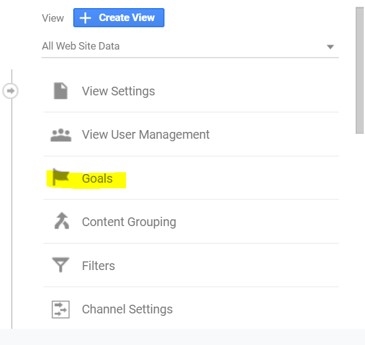
- Set a New Goal.
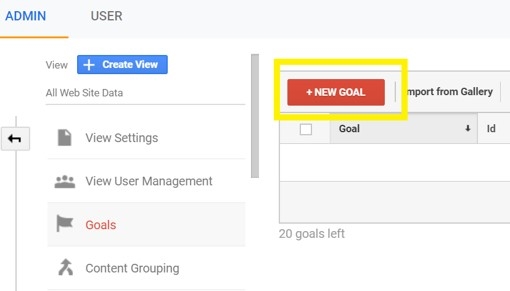
- On the next page, you can either pick an available Template or click Custom. In this case, pick the latter.
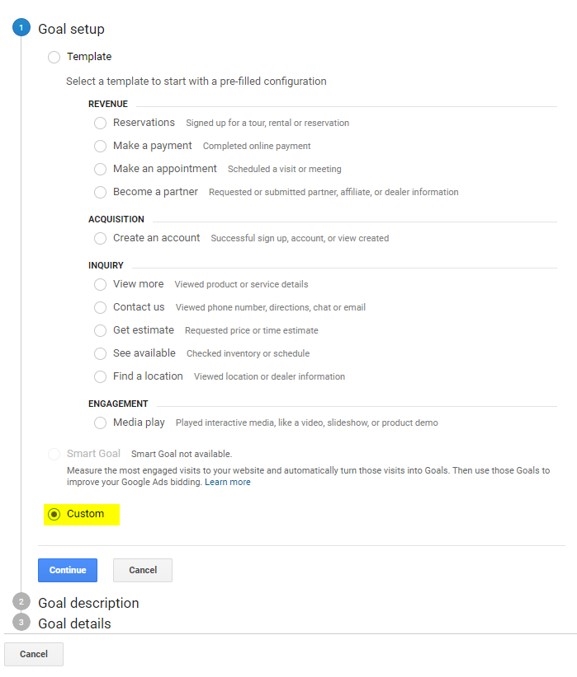
- Name your goal.
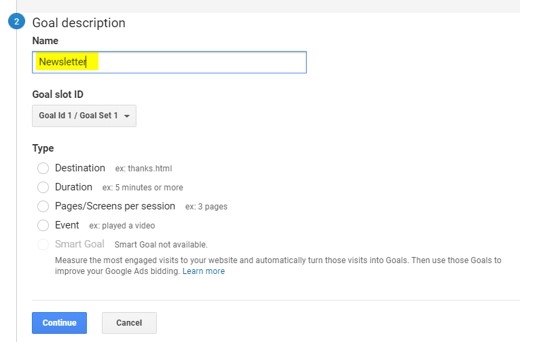
- Pick the Type for your goal. You’ll have four choices here: Destination (a specific location like your thank you page), Duration (sessions with a specific amount of time), Pages/Screens per session (when a user views a specific number of pages or screens), and Event (when a user fulfills an action like form submission or playing a video). Note that for Event type of goals, you need to set up event tracking on Google Tag Manager.
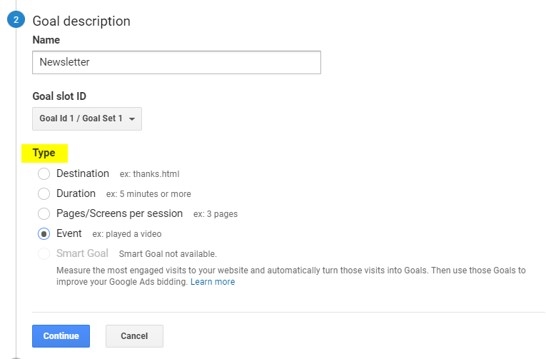
- The last step is setting up the parameters based on the type of goal that you picked. When you’re done, hit Save.
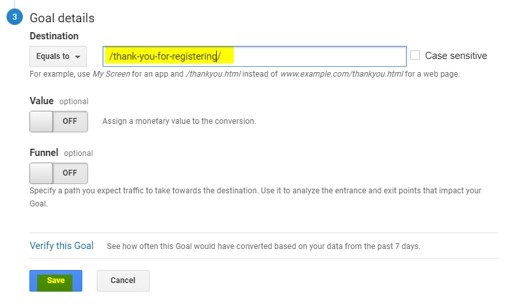
Ecommerce Conversions
If you’re running an ecommerce website with multiple products and product variations, GA will not be enough to track your goals. Google’s guide to tracking transactions and revenue is also too technical and will require you to work with a web developer.
Fortunately, most modern e-commerce platforms make this easy (e.g. Woocommerce, Shopify etc) as most of these platforms have settings that enable advanced ecommerce features. All you need to do is activate and integrate it with your GA. You’ll find the step-by-step guides for each platform on their respective websites.
Your Essential SEO Toolbox
There’s plenty of software out there, but these are the essentials in Superb Digital’s SEO arsenal that have helped us increase our clients’ ranks and conversions over the years:
1. Google Analytics
We’ve mentioned Google Analytics a lot in this article so it goes without saying it’s a requirement for any SEO campaign. This free tool is powerful enough that it can already give you a complete picture of how your site is performing and what else you can improve on.
Apart from the metrics we discussed earlier, GA also comes with advanced techniques, including funnels, channel attributions, categorising data into users and sessions, cross-device tracking, creating custom dimensions and metrics, segmenting your data, and so much more.
2. Google Search Console
I mentioned Google Search Console a couple of times in this article and for good reason as it’s an absolute essential when it comes to doing SEO. Unlike any other rank tracking tool out there, GSC is getting its data straight from Google so it is by far the most accurate and up to date.
Similar to GA, this free tool comes with powerful features that can help you optimise your visibility on the SERPs. Apart from indexing and checking how many of your pages are crawled per day, it can tell you which queries are bringing people to your site so you can improve your content. Google Search Console is also Google’s way of alerting you to on-site issues on your website and will tell you if you have any errors that need fixing, and optimise your pages for AMP, mobile use, and rich results.
3. Ahrefs
Ahrefs does a lot of things. If you want to find out what your competitors are doing for example, then Ahrefs is an absolute must. The tool provides competitive analysis to discover keywords your competitors are ranking for, your own keyword and backlink researcher, content research for the topics that work well in your niche, web monitoring, and accurate location-specific rank tracking.
There’s a 7-day trial for $ 7, then monthly prices start at $ 99 (1 user, 500 tracked keywords), $ 179 (1 user, 1500 tracked keywords), $ 399 (3 users, 5000 tracked keywords) and $ 999 (5 users, 10,000 tracked keywords), depending on the features and scale that you need.
4. Agency Analytics
There are a lot of reporting tools out there but we find Agency Analytics to be the most comprehensive. It allows users to create seamless reports (daily, weekly, monthly) and monitor multiple campaigns using a dashboard that you can custom fit according to your and your client’s needs. They also have tools for SEO auditing, social media, mobile apps, and more.
Free trial is available for 14 days. Afterward, you can pick from their $ 49, $ 149, and $ 399 per month packages.
5. SEMrush
SEMrush is an online visibility and marketing analytics software for both ecommerce and enterprise users. With more than 5 million users, SEMrush continues to be one of the top-rated software today, as its all-in-one toolkit contains analytics for SEO, PPC, social media, content and PR, and market research.
They have a 14-day free trial so you can see if their features work for you. Tiered packages range from $ 99 to $ 399 per month and they also offer a custom package for users who are looking for specific features.
6. Hotjar
If you want to know how users are behaving while they stay on your site (e.g. what are they looking at, what do they click on, etc.), Hotjar is the tool to use.
This is a behaviour analytics tool that uses heatmaps and records which parts of your site users explore and how far down they scroll. They also have a conversion funnel feature that will give you data on which page and at which step your visitors are dropping off.
Hotjar is free forever for their basic package, but prices can go up to $ 989 per month (or more) depending on how many pages you need to track per day.
7. Ruler Analytics
Ruler Analytics is a call tracking software that will tell you which channels are successfully sending calls, which channels are sending the best quality of leads, the visitors who converted, and which feature of your product the customers are most interested in. You can then upload this data in your CRM and add leads to your sales pipeline.
You can book a free demo with pricing starting at $ 125 to $ 199 per month.
8. Google Optimize
Finding out which version of your pages will give you the best results is vital if you want to get rid of the guesswork in your SEO campaigns and know with certainty how visitors are responding to your site. Continually testing also helps make sure that you’re staying ahead of the curve, especially when new algorithms come out or when your customers are changing their preferences.
Fortunately, Google’s tool for A/B testing is also free. It’s a pretty straightforward tool—it lets you test variants of your pages and see how each performs according to an objective. Apart from A/B tests, you can also conduct redirect and multivariate tests.
9. Google Sheets
Many of the tools I’ve listed here can present data in a variety of ways but you may want to integrate your data in a number of other ways and also compare and contrast it with other data from different tools (ie putting ranking data alongside bounce rate and search volume). Whilst Google Sheets doesn’t technically track data it is an essential tool to understanding, comparing and contrasting that data and presenting it in more understandable formats. Google Sheets are also collaborative so you can easily share them with your whole team as well as clients.
Digital & Social Articles on Business 2 Community
(105)






